Bartholins Cyst and Abscess

Bartholins Cyst and Abscess
Bartholin’s Glands
- The Bartholin’s glands are located on each side of the vaginal opening. Each gland produces a small amount of lubricating fluid that passes through a duct (tube) that opens on the skin near the hymen on each side.
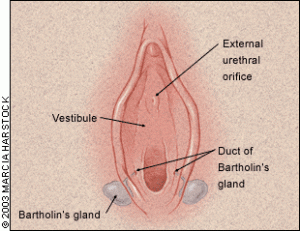
Bartholin’s Cyst
- Sometimes, the opening of a one of the ducts gets blocked.
- The secretions then build up inside the tube, which eventually expands and forms a cyst.
- You may notice the cyst as a round, painless or slightly tender bulge at one of the vaginal lips, near the opening of the vagina. It may stay the same size or may slowly grow larger. Sometimes the cyst gets infected, causing an abscess. (see below).
- Trauma, infection or friction can cause the small openings to get blocked or close. Sometimes we do not know why this happens. Just like skin pores can get clogged, causing a pimple, the Bartholin’s duct can also be clogged.
- About 2% of all women will develop a Bartholin’s cyst or abscess sometime during their life. They are commonly found in women between 20-29 years old.
- If the Bartholin’s cyst stays small and does not get infected, there is no reason for treatment. Keep an eye on it to make sure it does not grow or get infected.
- Often the cyst can be irritating and rub when you are wearing underwear or cause discomfort during sex.
- Treating it is a simple procedure and should be done if you are bothered by the cyst.
- Bartholin’s cysts are rarely dangerous or cancerous.
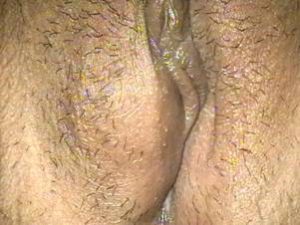
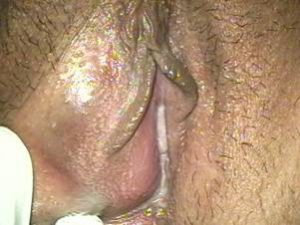
Bartholin’s Abscess
- If a Bartholin’s duct, cyst or gland becomes infected, an abscess will form. This can happen without a cyst being formed first.
- An abscess is just an infected contained area that has no way of releasing it’s fluid. This then gets bigger, red and painful.
- Abscesses are almost three times more common that cysts.
- A Bartholin’s abscess is noticed as a red, painful swelling at the bottom of the labia majora (the outer lips of the vulva).
- Usually the abscess is extremely tender, making sexual intercourse very painful and sometimes even making it hard to sit or walk.
- Antibiotics are not effective because of the poor blood supply to the abscess.
- The abscess has to be opened and drained.
Treatment of a Cyst or Abscess
- To make the gland work again and to have the lubricating fluid come out, we need to make a new opening.
- This is a small procedure done at our office.
- The procedure only takes a few minutes.
- This will give you immediate relief.
Options of treatment:
The goal of any treatment is to make a new opening near the original one, so that lubricating fluid can keep the area healthy and make sex easier. This is the lubrication that is secreted when you are aroused. Never allow a physician to make the opening over the most prominent area of the cyst or abscess if it is not right next to the hymen ridge, on the inside of your inner lips! This mistake, which is common, can result in the new opening being on the outside, so whenever you get aroused, the lubricating fluid runs down your thigh, rather than at your vaginal opening, where it is needed for lubrication during sex.
A few options and our comments:
Word Catheter:
This is the best treatment. A small 6 cm long tube with a tiny balloon on one end is used. (See the photo and diagram below). Once we have opened the abscess or cyst, we put the catheter tube into the opening to make sure that the skin does not close again. This is very successful. (80 – 90%). At Meridia, we use a LASER to make the opening, and our success rates are excellent using this method.
Antibiotics:
Using antibiotics for the abscess is not recommended because it is unlikely to work. For antibiotics to work there needs to be a good blood supply to the infection to kill the bugs. An abscess does not have a good blood supply. At Meridia Gynecology, we generally do not use antibiotics unless there is a complicated situation and surrounding skin infection.
Incision and Drainage:
This is simply opening the abscess or cyst and letting it drain. This works immediately, but unfortunately, this form of treatment has a high chance of the abscess / cyst coming back as soon as the opening closes again.
Marsupilization:
This is an old, standard treatment that makes a large opening and then sutures the inside edges of the duct to the skin to keep it open. The results of this method and the Word Catheter are the same. At Meridia Gynecology, we rarely use this method because it is unnecessary, causes a lot of discomfort and heals slowly. There are times when we need to do it, but those are very rare.
Word catheter insertion
- After examining the cyst/abscess, we give you local anaesthetic (freezing) to numb the area.
- The doctor will then open up the cyst/abscess, by making an incision or using LASER, at the same place as the duct opening once was. You will not feel this.
- The cyst/abscess can now be emptied on fluid/pus.
- The gland is then cleaned by flushing with a sterile solution and small connections inside are broken to free infection.
- We now insert the Word catheter.
- The Word catheter stays inside for 4-6 weeks. This keeps the duct open long enough for the new skin edges to heal and stay open.
- The catheter is held in place by a small balloon that is inflated inside. You will feel this balloon as a solid round object. It will not be painful.
- The free end of the catheter is easily tucked into your vagina.
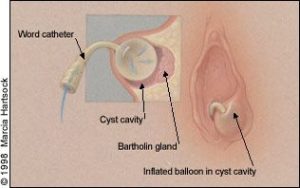
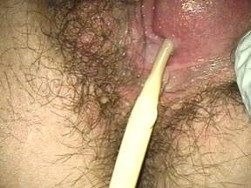
Living with a Word catheter
- Congratulations to your new Bartholin’s duct opening! The small catheter we placed inside will help the new skin edges heal, keeping the duct open.
- After the catheter insertion, it is important to keep the area clean and dry to prevent infections.
- Take sitz baths 2-3 times per day. A Sitz bath is a warm-water bath with Epson salts or Baking Soda added. You sit in the tub/basin only covering only the hips and buttocks. This will keep the area clean and promote healing and comfort. Splash the fluid against your vaginal opening and use your fingers to clean the area.
- Do not pull out the Catheter!
- The gland secretion will drain around the catheter. You can help this process by massaging, or “milking” lips downward when you are in the shower.
- You may have some discharge after the procedure. There can also be some spotting from the incision / LASER. As long as the bleeding does not increase, or there is no worsening of pain, swelling or fever, there is no need for concern.
- Wear a panty liner.
- After the catheter is inserted, the area can be irritated. This will settle down with time.
- If you have any of these symptoms, please come in right away!
- Increased pain
- Fever and chills
- Increased swelling in the operation area.
- Never have vaginal intercourse while the Word catheter is in place. This will be painful and you will rip the catheter out cause tearing and bleeding.
- Explore other ways to enjoy sex! Sexual intercourse can be resumed after the catheter is removed.
- The same applies for tampons – use pads as long as the catheter is in place.
- We recommend showering instead of taking baths.
- We will see you one week after the Word catheter insertion. At this appointment, we will make sure that the catheter is well placed and draining well.
- In 4 – 6 weeks we will remove the catheter. This takes a few seconds and is not painful.
- Even after the catheter has been removed, you will benefit from massaging the area. This will promote drainage and help keeping the duct open, preventing a new cyst/abscess from developing.
- There is about 20% risk of the cyst/abscess coming back. Please see us as soon as you notice a swelling.
